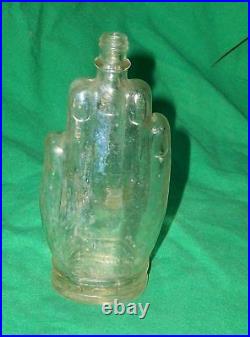
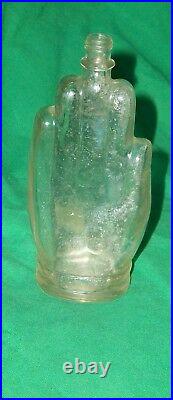
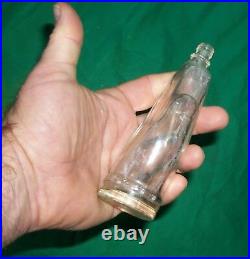
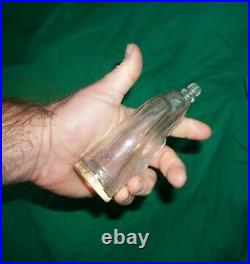
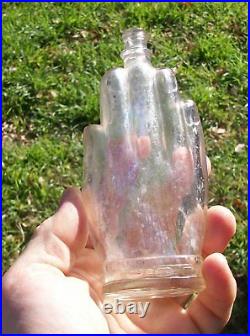
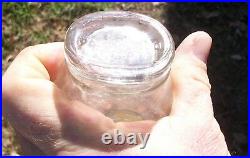
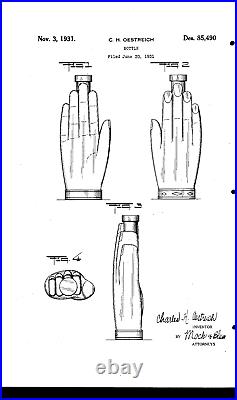

1931 OLD GLASS BOTTLE GYPSY HAND DEPRESSION ERA AMERICANA PATENT 85490 VTG WEIRD. GREETINGS, FEEL FREE TO. We are not experts. We welcome any comments, questions, or concerns. WE ARE TARGETING A GLOBAL MARKET PLACE. Thanks in advance for your patronage. Please Be sure to add WDG to your. NOW FOR YOUR VIEWING PLEASURE. OLD GLASS BOTTLE FIGURAL / FIGURE SHAPED LIKE A HAND / PALM MEASURES ABOUT 5.25″ X 2.25″ X 1.75 OLD PATENT NUMBER EMBOSSED 85490. L i uf c. OESTREICH 85,490 BOTTLE Filed June 20, 1951 I NVENTOR BY Mew ATTORNEYS Patented Nov. UNITED STATES PATENT OFFICE CHARLES H. OESTBEICH, 0F BROOKLYN, NEW YORK DESIGN FOR A BOTTLE Application filed June 20, 1931. Term of patent 14 years. To all whom it may concern: Fig. 1 is a perspective view of the front of Be it known that I, CHpzLEs H. A citizen of the United States, residing at Fig. 2 is a perspective View of the rear of Brookl 11, county of Kings, and State of the bottle. New ork, have invented anew, original, Fig. And ornamental Design for a Bottle of which Fig. 4 is a top plan view of the bottle. The following is a specification, reference be- I claim: ing had to the accompanying drawings, form- The ornamental design for a bottle substaning; part thereof. BOTTLE Filed June 20, 1951 I NVENTOR BY Mew ATTORNEYS Patented Nov. The drawings CHARLES H. LOOKS VERY FAMILAR TO THE “HEIL” OF THE SAME CENTURY. Quackery is the promotion of fraudulent or ignorant medical practices. A “quack” is a “fraudulent or ignorant pretender to medical skill” or “a person who pretends, professionally or publicly, to have skill, knowledge, or qualifications he or she does not possess; a charlatan”. The word quack derives from the archaic word quacksalver, of Dutch origin (spelled kwakzalver in contemporary Dutch), literally meaning “hawker of salve”. In the Middle Ages the word quack meant “shouting”. Common elements of general quackery include questionable diagnoses using questionable diagnostic tests, as well as alternative or refuted treatments, especially for serious diseases such as cancer. “Health fraud” is often used as a synonym for quackery, but quackery’s salient characteristic is its more aggressive promotion quacks quack! “Pseudo-medicine” is a term for treatments known to be ineffective, regardless of whether their advocates themselves believe in their effectiveness. In determining whether a person is committing quackery, the central question is what is acceptable evidence for the efficacy and safety of whatever treatments, cures, regimens, or procedures the alleged quack advocates. Since it is difficult to distinguish between those who knowingly promote unproven medical therapies and those who are mistaken as to their effectiveness, U. Courts have ruled in defamation cases that accusing someone of quackery or calling a practitioner a quack is not equivalent to accusing that person of committing medical fraud. To be both quackery and fraud, the quack must know they are misrepresenting the benefits and risks of the medical services offered (instead of, for example, promoting an ineffective product they honestly believe is effective). In addition to the ethical problems of promising benefits that can not reasonably be expected to occur, quackery also includes the risk that patients may choose to forego treatments that are more likely to help them, in favor of ineffective treatments given by the “quack”. To avoid semantic problems, quackery could be broadly defined as anything involving overpromotion in the field of health. This definition would include questionable ideas as well as questionable products and services, regardless of the sincerity of their promoters. In line with this definition, the word “fraud” would be reserved only for situations in which deliberate deception is involved. Quacksalver Unproven, usually ineffective, and sometimes dangerous medicines and treatments have been peddled throughout human history. Theatrical performances were sometimes given to enhance the credibility of purported medicines. Even where no fraud was intended, quack remedies often contained no effective ingredients whatsoever. Some remedies contained substances such as opium, alcohol and honey, which would have given symptomatic relief but had no curative properties. Some ingredients did have medicinal effects: mercury, silver and arsenic compounds may have helped some infections and infestations; willow bark contained salicylic acid, chemically closely related to aspirin; and the quinine contained in Jesuit’s bark was an effective treatment for malaria and other fevers. However, knowledge of appropriate uses and dosages was limited. Donnell coined the phrase “quackademic medicine” to describe this attention given to alternative medicine by academia. Referring to the Flexner Report, he said that medical education needs a good Flexnerian housecleaning. For example, David Gorski criticized Brian M. Berman, founder of the University of Maryland Center for Integrative Medicine, wrote: There was nevertheless evidence that both real acupuncture and sham acupuncture were more effective than no treatment and that acupuncture can be a useful supplement to other forms of conventional therapy for low back pain. He also castigated editors and peer reviewers at the New England Journal of Medicine for allowing it to be published, since it effectively recommended deliberately misleading patients in order to achieve a known placebo effect. With little understanding of the causes and mechanisms of illnesses, widely marketed “cures” (as opposed to locally produced and locally used remedies), often referred to as patent medicines, first came to prominence during the 17th and 18th centuries in Britain and the British colonies, including those in North America. Daffy’s Elixir and Turlington’s Balsam were among the first products that used branding e. Using highly distinctive containers and mass marketing to create and maintain markets. A similar process occurred in other countries of Europe around the same time, for example with the marketing of Eau de Cologne as a cure-all medicine by Johann Maria Farina and his imitators. The number of internationally marketed quack medicines increased in the later 18th century; the majority of them originated in Britain and were exported throughout the British Empire. By 1830, British parliamentary records list over 1,300 different “proprietary medicines, ” the majority of which were “quack” cures by modern standards. A Dutch organisation that opposes quackery, Vereniging tegen de Kwakzalverij was founded in 1881, making it the oldest organisation of this kind in the world. It has published its magazine Nederlands Tijdschrift tegen de Kwakzalverij (NTtdK, “Dutch Magazine against Quackery”) ever since. In these early years the Vereniging tegen de Kwakzalverij played a part in the professionalisation of medicine. Its efforts in the public debate helped to make the Netherlands one of the first countries with governmental drug regulation. In 1909, in an attempt to stop the sale of quack medicines, the British Medical Association published Secret Remedies, What They Cost And What They Contain. This publication was originally a series of articles published in the British Medical Journal between 1904 and 1909. [17] The publication was composed of 20 chapters, organising the work by sections according to the ailments the medicines claimed to treat. Each remedy was tested thoroughly, the preface stated: Of the accuracy of the analytical data there can be no question; the investigation has been carried out with great care by a skilled analytical chemist. The book did lead to the end of some of the quack cures, but some survived the book by several decades. For example, Beecham’s Pills (identified as containing only aloes, ginger and soap, but claiming to cure 31 medical conditions) were still on sale in 1997. British patent medicines started to lose their dominance in the United States when they were denied access to the American market during the American Revolution, and lost further ground for the same reason during the War of 1812. From the early 19th century “home-grown” American brands started to fill the gap, reaching their peak in the years after the American Civil War. British medicines never regained their previous dominance in North America, and the subsequent era of mass marketing of American patent medicines is usually considered to have been a “golden age” of quackery in the United States. This was mirrored by similar growth in marketing of quack medicines elsewhere in the world. In the United States, false medicines in this era were often denoted by the slang term snake oil, a reference to sales pitches for the false medicines that claimed exotic ingredients provided the supposed benefits. They often accompanied other theatrical and entertainment productions that traveled as a road show from town to town, leaving quickly before the falseness of their medicine was discovered. Not all quacks were restricted to such small-time businesses however, and a number, especially in the United States, became enormously wealthy through national and international sales of their products. One among many examples is that of William Radam, a German immigrant to the USA who, in the 1880s, started to sell his “Microbe Killer” throughout the United States and, soon afterwards, in Britain and throughout the British colonies. His concoction was widely advertised as being able to “Cure All Diseases” W. In fact, Radam’s medicine was a therapeutically useless (and in large quantities actively poisonous) dilute solution of sulfuric acid, coloured with a little red wine. Radam’s publicity material, particularly his books (see for example Radam, 1890), provide an insight into the role that pseudo-science played in the development and marketing of “quack” medicines towards the end of the 19th century. Similar advertising claims to those of Radam can be found throughout the 18th, 19th, 20th and 21st centuries. Another English quack, Dr. Solomon claimed that his Cordial Balm of Gilead cured almost anything, but was particularly effective against all venereal complaints, from gonorrhoea to onanism. Not all patent medicines were without merit. Turlingtons Balsam of Life, first marketed in the mid-18th century, did have genuinely beneficial properties. It can be argued that for some of these medicines this is an example of the infinite monkey theorem in action. The end of the road for the quack medicines now considered grossly fraudulent in the nations of North America and Europe came in the early 20th century. February 21, 1906 saw the passage into law of the Pure Food and Drug Act in the United States. This was the result of decades of campaigning by both government departments and the medical establishment, supported by a number of publishers and journalists (one of the most effective of whom was Samuel Hopkins Adams, whose series “The Great American Fraud” was published in Colliers Weekly starting in late 1905). This American Act was followed three years later by similar legislation in Britain, and in other European nations. Between them, these laws began to remove the more outrageously dangerous contents from patent and proprietary medicines, and to force quack medicine proprietors to stop making some of their more blatantly dishonest claims. Medical quackery and promotion of nostrums and worthless drugs were among the most prominent abuses that led to formal self-regulation in business and, in turn, to the creation of the NBBB. Contemporary culture Quackery is the promotion of false and unproven health schemes for a profit. It is rooted in the traditions of the marketplace”, with “commercialism overwhelming professionalism in the marketing of alternative medicine. Considered by many an archaic term, quackery is most often used to denote the peddling of the “cure-alls” described above. Quackery continues even today; it can be found in any culture and in every medical tradition. Unlike other advertising mediums, rapid advancements in communication through the Internet have opened doors for an unregulated market of quack cures and marketing campaigns rivaling the early 20th century. While quackery is often aimed at the aged or chronically ill, it can be aimed at all age groups, including teens, and the FDA has mentioned some areas where potential quackery may be a problem: breast developers, weight loss, steroids and growth hormones, tanning and tanning pills, hair removal and growth, and look-alike drugs. The best known of the Parisian charlatans was Tabarin, who set up a stage in the Place Dauphine, Paris in 1618, and whose commedia dell’arte inspired skits and whose farces inspired Molière. The word can also be traced to Spanish; charlatán, an indiscreetly talkative person, a chatterbox. Ultimately, etymologists trace “charlatan” from either the Italian ciarlare, to prattle; or from Cerretano, a resident of Cerreto, a village in Umbria, known for its quacks. In usage, a subtle difference is drawn between the charlatan and other kinds of confidence trickster. The charlatan is usually a salesperson. He does not try to create a personal relationship with his marks, or set up an elaborate hoax using roleplaying. The word calls forth the image of an old-time medicine show operator, who has long since left town by the time the people who bought his “snake oil” or similarly named tonic realize that it does not perform as advertised. In reported spiritual communications, a charlatan is a person who fakes evidence that a spirit is “making contact” with the medium and seekers. This has been challenged successfully by skeptics who wrote passwords and gave them to people of trust, containing a password that should be spoken by the person if he ever tried to make contact, to validate the truth of the claim. No such claim has been verified. Notable people who have successfully debunked the claims of purported supernatural mediums include magician/scientific skeptic James Randi, Brazilian writer Monteiro Lobato and magician Houdini. Synonyms for “charlatan” include “mountebank”, “shyster”, and “quack”. “Quack” is a reference to “quackery” or the practice of dubious medicine. (THIS PICTURE FOR DISPLAY ONLY). DO NOT BE TOO PERSNICKETY. Please leave feedback when you have received the item and are satisfied. Please respond when you have received the item. Our goal is for 5-star service. We want you to be a satisfied, return customer. Please express any concerns or questions. More pictures are available upon request. Please Check out our other items. WE like the curious and odd. Create your brand with Auctiva’s. Track Page Views With. Auctiva’s FREE Counter. The item “1931 OLD GLASS BOTTLE GYPSY HAND COLOGNE PERFUME DEPRESSION ERA PATENT HEIL VTG” is in sale since Tuesday, December 24, 2019. This item is in the category “Collectibles\Bottles & Insulators\Bottles\Modern (1900-Now)\Medicine”. The seller is “cbenhob” and is located in Jenks, Oklahoma. This item can be shipped worldwide.
- Country/Region of Manufacture: United States
- Color: Clear

